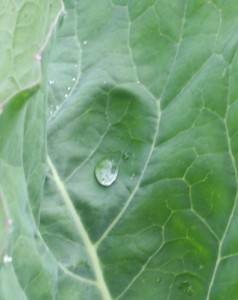
Cauliflower is a sneaky vegetable. Now don’t get me wrong. It’s a delicious vegetable…at least I think so.
This is the first time I have ever grown cauliflower. I bought plants at Lowe’s instead of starting it from seed. It was one of the first vegetables I planted in the new raised garden beds.
It’s a sneaky vegetable.
First, it grew leaves…HUGE leaves…enormous leaves. I’d carefully left the requisite amount of space between the plants as directed on the labels. Note to self: leave double that next year.
We watched in awe as the rain beaded on the waxy leaves. John looked it up in a book and found that scientists believe that some plants gained an evolutionary advantage by developing this ability. As we watched, the cauliflower leaves gently guided beads of water down into the thirsty heart of the plant.
But still…no cauliflower.
Just leaves.
Now REALLY big leaves.
Patience?
Um….no.
Total impatience. “C’mon cauliflower, I want to make dinner…grow!”
John spotted the cauliflower head first. “Come here and look – it’s the size of a baseball!” Sure enough, there was a beautiful head forming on one of the plants.
Yesterday after all the rain I went into the vegetable garden to pick strawberries and I stopped by to check on the cauliflower. That sneak. The head is now the size of a volleyball. And now two others have little cauliflower heads the size of baseballs….
Sneaky thing. I almost pulled you up. Stealth vegetables growing in the night and hiding from me. Keep growing!
Tips to Grow Cauliflower
- Cool season vegetable that according to the Illinois Cooperative Extension website is “more difficult to grow than other members of the cabbage family” (now you tell me!)
- Best to start from transplants
- Start in spring or fall
- 71 days to maturity (just about right, although mine took a tiny bit longer)
- More sensitive to cold than other cabbage family members (Kathleen said they like it around 72 degrees; I would agree with her. The cold snap we got in May probably slowed it down, making it longer than 71 days to maturity)
- Space 18-21 inches apart (mine are about 12 inches apart)
- Self blanch by tying the leaves over the head so the edible part doesn’t develop an off flavor (I didn’t do this, but may today…they look okay so far…those huge leaves served a purpose and just by having so many leaves it appears it did self blanch)
The picture today is one that I took. It’s my cauliflower leaves right after a rainstorm. I may frame this picture for my office. I have two garden photos I took hanging over my desk, a snap dragon and the mini hollyhock that looks like a weed.





OK- Good advice! I will leave it a little longer and see what happens. The plants are beautiful and it makes visitors to my garden think I really know what I am doing. lol
lol Congrats on finally achieving cauliflower prosperity. 🙂
I sense your excitement.
I look forward to the cauliflower recipes.
Heather – hope your broccoli comes out great.
Rob – the pressure is now on!
Kathleen – YOU DO READ MY BLOG! I am so honored. Hugs to you! Thank you for the patience “cauliflower coaching” LOL
Jeanne